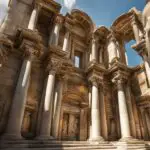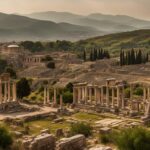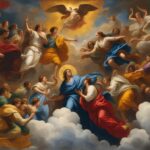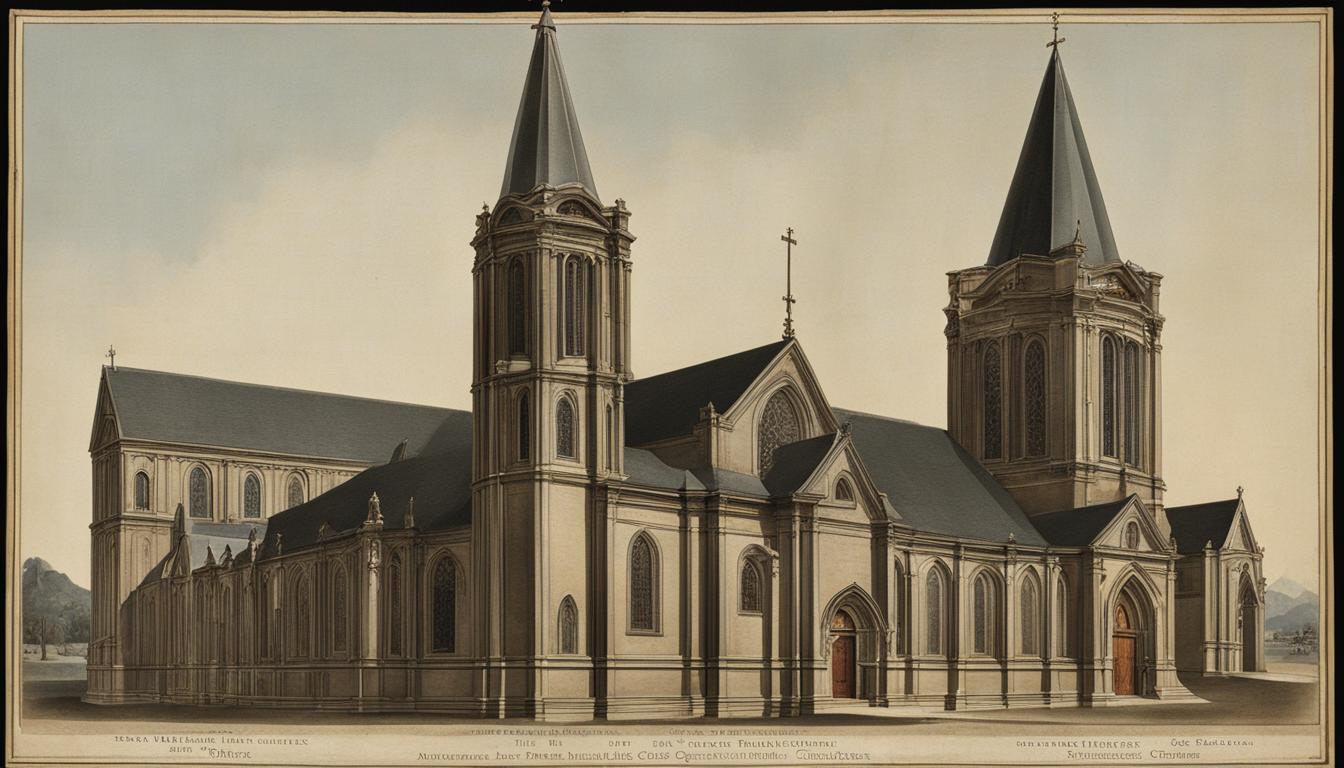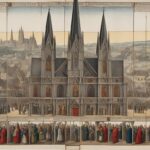Welcome to a journey through the rich history of the Thessalonian church, an early Christian community that played a vital role in shaping biblical history. Led by the esteemed Apostle Paul, this church emerged in the vibrant city of Thessalonica, located in modern-day Greece. From its humble beginnings to its enduring legacy, the Thessalonian church remains a testament to the power and relevance of the Christian faith.
From the moment Apostle Paul arrived in Thessalonica during his second missionary journey, the city became a thriving center of early Christianity. Despite facing opposition and persecution, Paul’s teachings resonated with the God-fearing Greeks and prominent women, leading to the formation of the Thessalonian church. This community laid the foundation for the spread of the Gospel and the establishment of Christian principles that continue to shape believers’ lives today.
The Thessalonian church embraced fundamental beliefs and doctrines of early Christianity. They professed the divinity of Jesus Christ, his redemptive sacrifice, and the importance of faith in receiving salvation. Their unwavering hope in the Second Coming of Christ and the promise of eternal life fueled their devotion and shaped their understanding of Christian doctrine.
Throughout their worship practices, the Thessalonian church engaged in sacred rituals and sacraments. Baptism, representing spiritual cleansing and initiation into the Christian faith, held a central place in their worship. Additionally, the communions during the Lord’s Supper reinforced their connection to Jesus Christ and his sacrifice.
The Thessalonian church was guided by appointed leaders and overseen by the Apostle Paul himself. These leaders, also known as elders or overseers, provided spiritual guidance, teachings, and pastoral care to the congregation. The wisdom and guidance of Apostle Paul, extended through his letters and personal visits, nurtured the growth of the Thessalonian church and fortified the faith of its believers.
In their worship gatherings, the Thessalonian church engaged in various practices that enhanced their spiritual connection with God. Through prayer, praise, and the singing of hymns, the believers communally worshiped God, creating an atmosphere of reverence and awe. The reading and exposition of sacred texts, particularly the letters and teachings of Apostle Paul, offered valuable insights that inspired and guided their faith.
Sacred texts, specifically the New Testament, held a revered place in the Thessalonian church. The letters written by the Apostle Paul to this church, known as 1 and 2 Thessalonians, provided a foundation of faith and instruction. These letters explored crucial aspects of Christian life, including the anticipation of Christ’s return, moral conduct, and the significance of living in light of the future Kingdom of God.
Over time, the Thessalonian church encountered divisions within the broader Christian community, leading to the emergence of various denominations and sects. These divisions were influenced by theological differences and varying interpretations of scripture. Nonetheless, the Thessalonian church’s shared history and common faith in Christ remained unifying factors amid the diversity of Christian groups.
The Thessalonian church had a profound commitment to building a strong community and actively engaging in outreach. They exemplified love, unity, and mutual care among believers, supporting one another and offering assistance when needed. Additionally, the Thessalonian church reached out to the wider society, spreading the message of Christ through acts of charity and service.
The Thessalonian church incorporated architectural and artistic features into their worship spaces to create a sacred atmosphere. While specific details are scarce, it is believed that elements such as mosaics, frescoes, and symbolic imagery adorned their gathering places, evoking a sense of wonder and devotion.
In the contemporary context, the Thessalonian church faces various challenges and issues that confront modern Christianity. Theological debates, cultural changes, social issues, and the influence of secularism are among the hurdles encountered. However, the Thessalonian church’s historical roots and the teachings of Christ provide a firm foundation for addressing these challenges and remaining faithful to their Christian identity.
As we delve into the diverse aspects of the Thessalonian church, let us discover the timeless lessons and insights that can inspire us in our spiritual journey. Join us as we unveil the captivating tapestry of the Thessalonian church, a beacon of light in the annals of early Christian faith.
Key Takeaways:
- The Thessalonian church, led by Apostle Paul, was an early Christian community in Thessalonica, Greece.
- The church embraced core Christian beliefs and doctrines, including faith in Jesus Christ and the hope of eternal life.
- Sacraments and rituals, such as baptism and the Lord’s Supper, were integral to the Thessalonian church’s worship practices.
- The church was guided by appointed leaders and overseen by Apostle Paul, whose letters provided spiritual guidance.
- Worship gatherings involved communal prayer, praise, singing of hymns, and the reading of sacred texts, particularly Apostle Paul’s letters.
Beliefs and Doctrines
The Thessalonian church, founded by the Apostle Paul, adhered to the core beliefs and doctrines of early Christianity. Their faith centered around the divinity of Jesus Christ and his role in the salvation of humanity through his death and resurrection. The Thessalonian believers understood that it was through faith in Christ that they could receive the gift of salvation.
Central to their beliefs was the emphasis on the Second Coming of Christ. The Thessalonians eagerly awaited his return and held onto the hope of eternal life in his kingdom. This anticipation shaped their understanding of the end times and influenced their daily lives.
The Thessalonian church upheld the teachings of the Apostle Paul as authoritative and foundational. Paul’s letters to the Thessalonians, particularly in 1 and 2 Thessalonians, provided guidance on various aspects of Christian living and reinforced their beliefs. These sacred texts were treasured by the church and served as a source of spiritual nourishment.
“For what is our hope or joy or crown of boasting before our Lord Jesus at his coming? Is it not you? For you are our glory and joy.” – 1 Thessalonians 2:19-20
The Thessalonian church’s beliefs and doctrines formed the bedrock of their faith, instilling in them hope, perseverance, and a deep sense of purpose. These timeless teachings continue to inspire and guide Christians today.
Sacraments and Rituals
The Thessalonian church engaged in various sacraments and rituals as part of their worship and spiritual practices. Baptism held significant importance as a symbol of initiation into the Christian faith and as an outward expression of one’s commitment to Christ and his teachings.
Communion, also known as the Lord’s Supper, was regularly observed by the church. It symbolized the sacrifice of Christ and served as a reminder of the believer’s union with him. The sharing of bread and wine represented the body and blood of Christ, reinforcing the spiritual bond among the members of the congregation.
In addition to these sacraments, prayer played a central role in the worship life of the Thessalonian church. It served as a means of communication with God, allowing believers to express their gratitude, seek guidance, and intercede for others. The church also devoted time to the reading and study of sacred texts, deepening their understanding of God’s word and its application to their lives.
| Sacraments and Rituals | Meaning and Significance |
|---|---|
| Baptism | A symbol of spiritual cleansing and initiation into the Christian faith. |
| Communion (Lord’s Supper) | Remembrance of Christ’s sacrifice and union of believers with him. |
| Prayer | A means of communication with God, expressing gratitude, seeking guidance, and interceding for others. |
| Reading and Study of Sacred Texts | Deepening understanding of God’s word and its application to their lives. |
The sacraments and rituals practiced by the Thessalonian church fostered a deep sense of spiritual connection and provided opportunities for believers to express their devotion to God and their fellow believers.
Sacraments and Rituals
In the Thessalonian church, the practice of sacraments and rituals held great significance in their worship. These observances were deeply rooted in their faith and served as transformative experiences for the believers.
Baptism: A Symbol of Spiritual Cleansing and Initiation
The Thessalonian church considered baptism as a pivotal sacrament. Through this ritual, individuals were symbolically cleansed of their sins and initiated into the Christian faith. It marked the beginning of their new spiritual journey and affirmed their commitment to following Christ. Baptism served as a powerful testimony of their faith and demonstrated their desire to live according to the teachings of Jesus.
Communion: Remembering and Proclaiming the Sacrifice of Christ
Communion, also known as the Lord’s Supper, was regularly observed in the Thessalonian church. It was a sacred ritual where believers gathered to remember and proclaim the sacrifice of Christ. By partaking in the bread and wine, they symbolically shared in the body and blood of Jesus, acknowledging the significance of His death and resurrection. This act of remembrance fostered unity among the believers and reinforced their commitment to the central message of the Gospel.
Rituals of Prayer, Worship, and Sacred Texts
Alongside the sacraments, the Thessalonian church engaged in various rituals of prayer, worship, and the reading of sacred texts. Prayer was an essential aspect of their worship, allowing them to communicate with God and seek His guidance and provision. Worship was characterized by heartfelt praise and adoration, as believers expressed their gratitude and reverence towards the Creator. The reading and exposition of sacred texts, particularly the letters and teachings of the Apostle Paul, provided spiritual nourishment and guidance for the Thessalonian church.

“The Thessalonian church practiced sacraments such as baptism and Communion, which were powerful expressions of their faith. These rituals served as transformative experiences that united believers and deepened their spiritual connection with God. Through prayer, worship, and the reading of sacred texts, the Thessalonian church nurtured their relationship with the divine and found solace in the teachings of the Apostle Paul. These sacraments and rituals continue to be an integral part of Christian worship, reminding believers of the sacrificial love of Jesus and fostering unity within the community.”
Leadership and Clergy
The Thessalonian church was blessed with appointed leaders who provided guidance and spiritual care to the congregation. Under the watchful eye of the Apostle Paul, these elders, also known as overseers, played a vital role in nurturing the faith of the believers and ensuring the smooth functioning of the church.
These appointed leaders were responsible for teaching the foundational truths of the faith, offering counsel and support to the members, and overseeing the overall spiritual well-being of the community. Their wisdom, experience, and unwavering dedication served as a beacon of inspiration for the early Thessalonian church.
Through his letters and personal visits, the Apostle Paul actively played his part in shaping the leadership of the Thessalonian church. His teachings, inspired by divine revelation, provided invaluable guidance on matters of doctrine, community-building, and the challenges faced by the believers.
Paul’s leadership and mentorship set a high standard for the clergy of the Thessalonian church, emphasizing the importance of servant leadership, humility, and a deep commitment to the Gospel. The leadership in the Thessalonian church understood the weight of their responsibility and fervently served the congregation, motivated by their love for Christ and a desire to emulate the example set by the Apostle Paul.
“Leadership is not about being in charge. It is about taking care of those in your charge.”

Qualities of Thessalonian Church Leadership
- A heart of servanthood, leading by example
- Courageous in the face of opposition and adversity
- Committed to the teachings of Apostle Paul and upholding sound doctrine
- Compassionate and caring, tending to the needs of the congregation
- Guided by humility and a deep reverence for God
The Thessalonian church is a testament to the importance of strong leadership within a faith community. The appointed leaders and the guidance of the Apostle Paul contributed significantly to the growth and spiritual development of the church, leaving a legacy that continues to inspire believers today.
Worship Practices
The worship practices of the Thessalonian church were central to their spiritual life and communal gatherings. These practices were rooted in their faith in Jesus Christ and influenced by the teachings of the Apostle Paul.
The believers of the Thessalonian church came together regularly to worship as a community, expressing their devotion and gratitude to God. During these gatherings, they engaged in various forms of worship, incorporating prayer, praise, and thanksgiving. Through their heartfelt prayers, the Thessalonian believers communicated their deepest desires and sought guidance and blessings from the divine.

The Thessalonian church also valued the power of music and singing in their worship. Hymns and spiritual songs were an integral part of their worship gatherings, allowing the believers to express their adoration and devotion to God through melodious voices. The act of singing together fostered unity among the congregation and created an atmosphere of reverence and joy.
The reading and exposition of sacred texts, particularly the letters and teachings of the Apostle Paul, held great significance in the worship practices of the Thessalonian church. The believers eagerly listened to the words of Paul, carefully studying and reflecting on his instructions and guidance. The sacred texts provided them with spiritual nourishment, deepening their understanding of the Christian faith and encouraging them to live out their beliefs in practical ways.
Through their worship practices, the Thessalonian church demonstrated their reverence for God, their commitment to fellowship, and their desire for spiritual growth. These practices served as a powerful expression of their faith and devotion, drawing them closer to God and strengthening their bond as a community of believers.
Inspiring Quotes:
“Let everything that has breath praise the Lord.” – Psalm 150:6
“Sing to the Lord a new song; sing to the Lord, all the earth.” – Psalm 96:1
Key Worship Practices of the Thessalonian Church:
- Prayer, praise, and thanksgiving
- Singing hymns and spiritual songs
- Reading and exposition of sacred texts, particularly the teachings of Apostle Paul
These worship practices were a vital part of the Thessalonian church’s spiritual life and played a significant role in their relationship with God and the growth of their faith.
The Sacred Texts of the Thessalonian Church
The Thessalonian church held the sacred texts of the New Testament in high regard. These ancient writings served as a guiding light for their faith and practices. Among these sacred texts, the letters penned by the Apostle Paul specifically addressed the Thessalonian church. Known as 1 and 2 Thessalonians, these epistles contained invaluable teachings on various aspects of Christian life.
In his letters, Apostle Paul expounded on profound themes such as the Second Coming of Christ, moral conduct, and the significance of eagerly awaiting the future Kingdom of God. These teachings provided the Thessalonian believers with spiritual guidance and instruction for navigating their journey of faith.
By studying and internalizing these sacred texts, the Thessalonian church embraced the transformative power of the Gospel message. They drew strength, inspiration, and understanding from the Apostle Paul’s words, applying them to their daily lives and shaping their identity as followers of Christ.

“Carry on the traditions that you were taught by word of mouth or by hearsay from us… May the Lord guide your hearts to express God’s love and perseverance as seen in Christ.”
These sacred texts not only provided theological teachings but also served as a source of encouragement and motivation for the Thessalonian church. They deepened their understanding of God’s love, strengthened their resolve to persevere, and fostered unity among believers.
Teachings in 1 Thessalonians:
- The imminent return of Jesus Christ (1 Thessalonians 4:13-18)
- The importance of living a morally upright life (1 Thessalonians 4:3-8)
- The significance of brotherly love and mutual edification (1 Thessalonians 5:11-15)
Teachings in 2 Thessalonians:
- The need for steadfastness and endurance in the face of adversity (2 Thessalonians 1:4)
- The warning against false teachings and the importance of holding fast to the truth (2 Thessalonians 2:15)
- The call to live worthy of God’s calling and to apply oneself diligently (2 Thessalonians 1:11-12)
The Thessalonian church cherished these sacred texts not only for their historical and theological significance but also for the practical wisdom they contained. They recognized that studying and reflecting on these writings would deepen their faith, guide their actions, and shape their collective identity as the Thessalonian church.
| Key Teachings and Themes | References |
|---|---|
| The Second Coming of Christ | 1 Thessalonians 4:13-18 |
| Moral Conduct and Upright Living | 1 Thessalonians 4:3-8 |
| Brotherly Love and Mutual Edification | 1 Thessalonians 5:11-15 |
| Steadfastness and Endurance in Adversity | 2 Thessalonians 1:4 |
| Warning Against False Teachings | 2 Thessalonians 2:15 |
| Living Worthy of God’s Calling | 2 Thessalonians 1:11-12 |
These sacred texts continue to resonate with believers today, transcending time and offering timeless wisdom. They inspire Christians to embrace the teachings of the Apostle Paul, emulate the virtues described in the Thessalonian letters, and live out their faith with hope, love, and perseverance.
Denominations and Sects
As time passed, the influence of the Thessalonian church expanded, giving rise to various denominations and sects within the broader Christian community. These divisions emerged due to distinct theological differences and interpretations of scripture. Each group developed its unique set of beliefs, practices, and organizational structures, shaping the course of Christianity. However, amidst these divisions, the Thessalonian church remained united by their shared history and unwavering faith in Christ.
Throughout history, denominations and sects within the Christian faith have taken different paths, emphasizing diverse aspects of doctrine and worship. Some have formed through charismatic leaders or theological disputes, while others have emerged in response to cultural or social influences. Despite their differences, these Christian groups continue to reflect the enduring legacy of the Thessalonian church and contribute to the vibrant tapestry of Christianity worldwide.
“In essentials, unity; in non-essentials, liberty; in all things, charity.”
Influence and Divergence
While the Thessalonian church may have birthed these denominations and sects, it is essential to recognize their shared roots and common commitment to faith in Christ. Each denomination and sect brings its unique perspectives and cultural expressions to the Christian faith, enriching its diversity and depth. The growth and development of these Christian groups demonstrate the dynamic nature of Christianity and its ability to adapt and respond to changing times.
Embracing Unity
Despite the existence of denominations and sects, there is a growing awareness among Christians today of the need for unity and collaboration. Many Christian groups are actively working towards finding common ground, building bridges, and embracing the shared core beliefs that unite them. Recognizing the common heritage derived from the Thessalonian church, Christians strive to foster interdenominational and ecumenical relationships, seeking to promote unity while respecting the unique contributions of each group.
Remaining Grounded in Faith
Amidst the diversity of Christian denominations and sects, it is crucial to remember the unifying thread that binds them together—their faith in Christ. While theological debates and differences in worship practices may exist, the belief in the life, death, and resurrection of Jesus Christ remains central. Christians from different denominations and sects find solace in knowing that, ultimately, their shared faith in Christ supersedes any divisions that may arise. It is through this shared faith that they strive to live out the teachings of Christ and bring about positive change in the world.
| Denomination/Sect | Beliefs and Practices | Founding Figures |
|---|---|---|
| Orthodox Christianity | Emphasizes liturgical worship, sacraments, and the authority of tradition | Early Church Fathers; notable figures include St. Basil the Great and St. John Chrysostom |
| Roman Catholicism | Recognizes the primacy of the Pope, seven sacraments, and the veneration of saints | Peter the Apostle; various Popes throughout history |
| Protestantism | Biblical authority, salvation by faith alone, and the priesthood of all believers | Martin Luther, John Calvin, and other reformers |
| Evangelicalism | Emphasizes personal conversion, evangelism, and the authority of scripture | John Wesley, George Whitefield, and other revivalists |
| Pentecostalism | Emphasizes the gifts of the Holy Spirit, including speaking in tongues and divine healing | Charles Parham, William Seymour, and other early Pentecostal leaders |

Community and Outreach
The Thessalonian church was deeply rooted in community, fostering a sense of belonging among its members. They shared a strong bond of fellowship, actively supporting one another through acts of care and assistance. The early Christian believers exemplified the love and unity that characterized their community, serving as a guiding example for future generations.
Embracing their mission of spreading the Gospel, the Thessalonian church actively engaged in outreach activities. They boldly shared the message of Christ with the broader society, reaching out to those who had not yet heard the Good News. Through acts of charity and service, they demonstrated the transformative power of Christ’s love and compassion.
Driven by their commitment to building a strong community and fulfilling their early Christian mission, the Thessalonian church became influential in their local context. Their outreach efforts not only touched the lives of individuals but also contributed to the broader societal impact of the early Christian movement. By actively living out their faith, the Thessalonian believers became beacons of hope and agents of change.
Architectural and Artistic Features
The Thessalonian church, like other early Christian communities, incorporated various architectural and artistic features into their worship spaces. While specific details about their buildings and artistic expressions may be scarce, it can be assumed that they utilized elements such as mosaics, frescoes, and symbolic imagery to create a sacred environment for worship.
These architectural and artistic features served to visually represent their faith and inspire a sense of awe and reverence among worshipers. Through intricate mosaics, vibrant frescoes, and carefully crafted symbols, the Thessalonian church sought to convey the beauty and significance of their early Christian worship.
“The artistic expressions found within the Thessalonian church not only adorned the physical spaces but also provided a deeper spiritual experience for the worshipers. The use of symbolic imagery allowed believers to connect with the stories and teachings of their faith, fostering a sense of reverence and awe in the presence of God.”
While the exact details of these architectural and artistic features may remain shrouded in history, their existence and influence on early Christian worship cannot be denied. They played a vital role in creating a sacred atmosphere that enhanced the worship experience and communicated the depth of the believers’ devotion.
Despite the passage of time, the Thessalonian church’s architectural and artistic legacy continues to inspire and captivate the imagination of modern-day Christians. It serves as a testament to the enduring power of artistic expression and its ability to transcend time and communicate the profound truths of the Christian faith.
Contemporary Issues and Challenges
In the modern context, the Thessalonian church continues to face contemporary issues and challenges. As a steadfast pillar of faith, the church must navigate these obstacles while remaining faithful to its historical roots and the teachings of Christ.
“In the midst of the complexities of modern life, the Thessalonian church remains a beacon of hope and resilience, transcending the challenges of the times.”
Theological debates pose one of the significant challenges for the Thessalonian church. As the interpretations and understanding of scripture evolve, the church must engage in thoughtful dialogue to address theological nuances and maintain orthodoxy. This helps ensure that the teachings passed down from the apostles continue to guide believers in the present day.
Adapting to cultural changes is another area of concern for the Thessalonian church. As societal values shift, the church must discern how to remain rooted in biblical truths while effectively engaging with contemporary culture. Striking a balance between timeless principles and relevant expressions of faith is essential to maintaining relevance and attracting new generations of believers.
The Thessalonian church also faces the challenge of navigating social issues. In an increasingly divided world, the church is called to be a voice of love, justice, and reconciliation. This involves addressing issues such as poverty, inequality, injustice, and human rights, aligning the church’s actions with the teachings of Christ.
Sustaining the faith of believers in an increasingly secular world is yet another challenge for the Thessalonian church. As secularism and skepticism gain prominence, the church must provide a firm foundation for believers to stand on. Nurturing a vibrant, transformative faith and equipping believers to engage with the secular world become crucial in preserving the church’s influence.
| Challenges | Solutions |
|---|---|
| Addressing theological debates | Engage in respectful dialogue and study of Scripture Seek guidance from spiritual leaders and theologians |
| Adapting to cultural changes | Embrace the timeless principles of Scripture while contextualizing their expression Engage with contemporary culture through relevant outreach and communication strategies |
| Navigating social issues | Advocate for justice and reconciliation through partnerships with local organizations Initiate community-based projects addressing societal needs |
| Sustaining faith in a secular world | Provide discipleship programs and resources for spiritual growth Equip believers with apologetic tools to address skepticism |
The Thessalonian church’s commitment to addressing these contemporary issues and challenges enables it to be a relevant and transformative force in modern Christianity. By holding fast to its historical legacy and embodying the teachings of Christ, the Thessalonian church inspires believers to overcome obstacles and stand firm in their faith.
Conclusion
The Thessalonian church stands as a powerful testament to the enduring legacy of early Christian faith. Despite the challenges they faced, the believers in Thessalonica remained steadfast in their devotion to Christ, leaving behind a remarkable legacy that continues to inspire believers today.
The Thessalonian church’s unwavering commitment to the Gospel and their deep-rooted sense of community serve as timeless lessons for Christians around the world. Their faith in the divinity of Jesus Christ and the anticipation of His second coming remain foundations of the Christian faith to this day.
Throughout history, the Thessalonian church has left an indelible mark on the development of Christianity. Their teachings, recorded in sacred texts such as the letters of the Apostle Paul, have provided spiritual guidance and instruction for centuries. The Thessalonian believers’ dedication to worship practices, including baptism and communion, highlights the importance of sacraments in the expression of faith.
As subsequent generations faced theological debates, cultural changes, and societal challenges, the enduring legacy of the Thessalonian church served as a beacon of light. Today, the Thessalonian church continues to inspire believers to navigate contemporary issues while remaining rooted in the timeless truths of the Christian faith. The Thessalonian legacy is a testament to the power and relevance of the early Christian faith, leaving a lasting impact on the modern world.
FAQ
What is the history of the Thessalonian Church?
The Thessalonian Church was established in Thessalonica, a prominent city in Macedonia, during biblical times. It was founded by the Apostle Paul during his second missionary journey.
What were the beliefs and doctrines of the Thessalonian Church?
The Thessalonian Church embraced the core beliefs of early Christianity, including the divinity of Jesus Christ, his death and resurrection for salvation, and the importance of faith in him for receiving salvation. They also emphasized the Second Coming of Christ and the hope of eternal life.
What sacraments and rituals did the Thessalonian Church practice?
The Thessalonian Church practiced baptism as a symbol of spiritual cleansing and initiation into the Christian faith. They also observed the Lord’s Supper, or communion, to remember and proclaim the sacrifice of Christ. Additionally, they engaged in prayer, worship, and the reading of sacred texts.
Who led the Thessalonian Church?
The Thessalonian Church was led by appointed leaders known as elders or overseers. The Apostle Paul also played a significant role in their guidance and provided pastoral care through his letters and visits.
What were the worship practices of the Thessalonian Church?
The Thessalonian Church gathered for communal worship, offering prayers, praise, and thanksgiving to God. They also engaged in singing hymns and spiritual songs and relied on the reading and exposition of sacred texts, particularly the letters of the Apostle Paul.
What were the sacred texts of the Thessalonian Church?
The Thessalonian Church revered the New Testament, particularly the letters written by the Apostle Paul to their community (1 and 2 Thessalonians), as sacred texts that guided their faith and practices.
Did the Thessalonian Church give rise to different denominations and sects?
Yes, over time, the Thessalonian Church gave rise to various denominations and sects within the broader Christian community. These divisions were influenced by theological differences and interpretations of scripture.
How did the Thessalonian Church engage in community and outreach?
The Thessalonian Church fostered a sense of community among its members, supporting one another through mutual care and assistance. They also reached out to the broader society, sharing the message of Christ and engaging in acts of charity and service.
What were the architectural and artistic features used in the Thessalonian Church?
While specific details are scarce, it can be assumed that the Thessalonian Church incorporated elements such as mosaics, frescoes, and symbolic imagery to create a sacred environment for worship.
What are the contemporary issues and challenges faced by the Thessalonian Church?
The Thessalonian Church, like modern Christianity, faces challenges such as theological debates, adapting to cultural changes, navigating social issues, and sustaining the faith of believers in an increasingly secular world.
What is the legacy of the Thessalonian Church?
The Thessalonian Church’s enduring legacy lies in their faithfulness to the Gospel, commitment to community, and anticipation of Christ’s return. They serve as a testament to the enduring power and relevance of the Christian faith throughout history.








